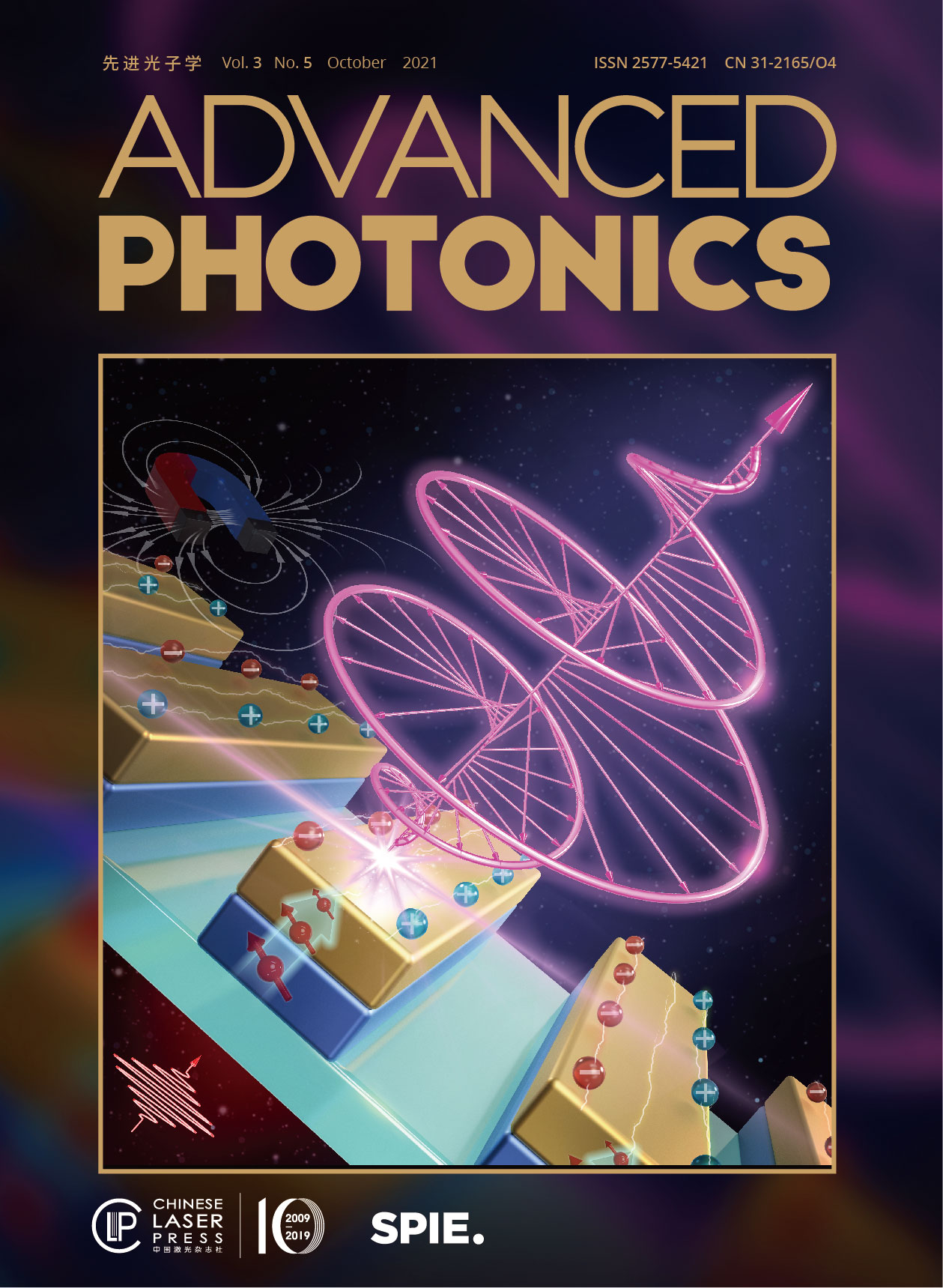 View fulltext
View fulltext
Schematic of the generation of chiral terahertz waveforms from a stripe-patterned spintronic-metasurface terahertz emitter under an external magnetic field. Typical time dependence of the electric-field vector for a chiral terahertz waveform generated from a spintronic-metasurface emitter.
Jiuzhang 2.0 represents significant improvements, beyond the last year’s landmark.
Solid-state atomic-sized color centers in wide-band-gap semiconductors, such as diamond, silicon carbide, and hexagonal boron nitride, are important platforms for quantum technologies, specifically for single-photon sources and quantum sensing. One of the emerging applications of these quantum emitters is subdiffraction imaging. This capability is provided by the specific photophysical properties of color centers, such as high dipole moments, photostability, and a variety of spectral ranges of the emitters with associated optical and microwave control of their quantum states. We review applications of color centers in traditional super-resolution microscopy and quantum imaging methods, and compare relative performance. The current state and perspectives of their applications in biomedical, chemistry, and material science imaging are outlined.
We predict theoretically a regime of photon-pair generation driven by the interplay of multiple bound states in the continuum resonances in nonlinear metasurfaces. This nondegenerate photon-pair generation is derived from the hyperbolic topology of the transverse phase matching and can enable orders-of-magnitude enhancement of the photon rate and spectral brightness, as compared to the degenerate regime. We show through comprehensive simulations that the entanglement of the photon pairs can be tuned by varying the pump polarization, which can underpin future advances and applications of ultracompact quantum light sources.
Integrated photonics provides a route to both miniaturization of quantum key distribution (QKD) devices and enhancing their performance. A key element for achieving discrete-variable QKD is a single-photon detector. It is highly desirable to integrate detectors onto a photonic chip to enable the realization of practical and scalable quantum networks. We realize a heterogeneously integrated, superconducting silicon-photonic chip. Harnessing the unique high-speed feature of our optical waveguide-integrated superconducting detector, we perform the first optimal Bell-state measurement (BSM) of time-bin encoded qubits generated from two independent lasers. The optimal BSM enables an increased key rate of measurement-device-independent QKD (MDI-QKD), which is immune to all attacks against the detection system and hence provides the basis for a QKD network with untrusted relays. Together with the time-multiplexed technique, we have enhanced the sifted key rate by almost one order of magnitude. With a 125-MHz clock rate, we obtain a secure key rate of 6.166 kbps over 24.0 dB loss, which is comparable to the state-of-the-art MDI-QKD experimental results with a GHz clock rate. Combined with integrated QKD transmitters, a scalable, chip-based, and cost-effective QKD network should become realizable in the near future.
Optical parametric oscillators (OPOs) have been widely applied in spectroscopy, squeezed light, and correlated photons, as well as quantum information. Conventional OPOs usually suffer from a high power threshold limited by weak high-order nonlinearity in traditional pure photonic systems. Alternatively, polaritonic systems based on hybridized exciton–photon quasi-particles exhibit enhanced optical nonlinearity by dressing photons with excitons, ensuring highly nonlinear operations with low power consumption. We report an on-chip perovskite polariton parametric oscillator with a low threshold. Under the resonant excitation at a range of angles, the signal at the ground state is obtained, emerging from the polariton–polariton interactions at room temperature. Our results advocate a practical way toward integrated nonlinear polaritonic devices with low thresholds.
A Dirac point is a linear band crossing point originally used to describe unusual transport properties of materials like graphene. In recent years, there has been a surge of exploration of type-II Dirac/Weyl points using various engineered platforms including photonic crystals, waveguide arrays, metasurfaces, magnetized plasma and polariton micropillars, aiming toward relativistic quantum emulation and understanding of exotic topological phenomena. Such endeavors, however, have focused mainly on linear topological states in real or synthetic Dirac/Weyl materials. We propose and demonstrate nonlinear valley Hall edge (VHE) states in laser-written anisotropic photonic lattices hosting innately the type-II Dirac points. These self-trapped VHE states, manifested as topological gap quasi-solitons that can move along a domain wall unidirectionally without changing their profiles, are independent of external magnetic fields or complex longitudinal modulations, and thus are superior in comparison with previously reported topological edge solitons. Our finding may provide a route for understanding nonlinear phenomena in systems with type-II Dirac points that violate the Lorentz invariance and may bring about possibilities for subsequent technological development in light field manipulation and photonic devices.
The ability to generate and manipulate broadband chiral terahertz waves is essential for applications in material imaging, terahertz sensing, and diagnosis. It can also open up new possibilities for nonlinear terahertz spectroscopy and coherent control of chiral molecules and magnetic materials. The existing methods, however, often suffer from low efficiency, narrow bandwidth, or poor flexibility. Here, we propose a novel type of laser-driven terahertz emitters, consisting of metasurface-patterned magnetic multilayer heterostructures, that can overcome the shortcomings of the conventional approaches. Such hybrid terahertz emitters combine the advantages of spintronic emitters for being ultrabroadband, efficient, and highly flexible, as well as those of metasurfaces for the powerful control capabilities over the polarization state of emitted terahertz waves on an ultracompact platform. Taking a stripe-patterned metasurface as an example, we demonstrate the efficient generation and manipulation of broadband chiral terahertz waves. The ellipticity can reach >0.75 over a broad terahertz bandwidth (1 to 5 THz), representing a high-quality and efficient source for few-cycle circularly polarized terahertz pulses with stable carrier waveforms. Flexible control of ellipticity and helicity is also demonstrated with our systematic experiments and numerical simulations. We show that the terahertz polarization state is dictated by the interplay between laser-induced spintronic-origin currents and the screening charges/currents in the metasurfaces, which exhibits tailored anisotropic properties due to the predesigned geometric confinement effects. Our work opens a new pathway to metasurface-tailored spintronic emitters for efficient vector-control of electromagnetic waves in the terahertz regime.














